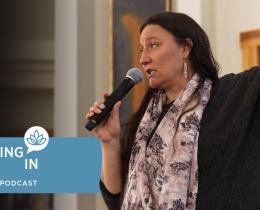As we pass through life on the physical plane, things happen. We contract flus, colds, and viruses, and we sustain physical injuries. As children, we may have fallen off our bicycle. As adults, we may throw our back out or experience a serious car accident. In the process of these incidents, we often acquire bruises, cuts, sprains, infections, lacerations, and sometimes broken bones.
Some of us may also experience serious illnesses of an internal nature, like cancer, hepatitis, heart disease, or multiple sclerosis. Eventually, we pass through old age and the progressive infirmity and death of the physical body. These are the givens—they are all to be expected as part of what it means to be an embodied, living being. But these are all effects, and what the shaman is primarily interested in is the cause.
Cause & Effect
In looking through the shamanic healer’s eyes, the ultimate causes of virtually all illnesses are to be found within the imaginal realms—those same regions from which illnesses derive their initial power to affect us adversely. Because of this, it is not enough to simply suppress the effects of illness with medication on the physical plane and hope for the best. For true healing to occur, the causes of the illness must be addressed.
From the shaman’s perspective, there are three classic causes of illnesses, and they are not microbes, bacteria, or viruses. Rather, they are negative internal states that appear within us in response to negative or traumatic life experiences. The first among these is disharmony.
Disharmony
Disharmony is what we experience when life suddenly loses its meaning, or when we have lost an important connection to life.
Let’s take the case of an elderly couple who have had a long marriage. They may not have had a perfect relationship, yet there is a deep bond between them because of all they have shared together. Suddenly, the wife dies. The husband may go into crisis upon the loss of his wife, and within a short time, he may come down with something medically challenging, like cancer. Suddenly, he’s gone, too. That’s disharmony.
The state of disharmony that we experience in response to such life situations causes a diminishment of our personal power. This can happen in a subtle manner or in a catastrophic way. In either case, when we experience disempowerment, or “power loss,” it affects our energetic matrix, rendering us vulnerable to illness.
Fear
The second classic cause of illness is fear. A person who is walking around with a chronic sense of fear gnawing away at them is doubly vulnerable to illness because their anxiety aggressively and progressively diminishes their sense of well-being, and this, in turn, influences their feeling of being safe in the world.
This sense of well-being is the base upon which our personal health system stands. When this foundation is affected negatively, it diminishes the ability of our immune system to function. And when our immune system goes down, we’re in trouble.
It’s not too difficult to see that there is a feedback mechanism at work here. Fear, and the anxiety it creates, produces disharmony. Disharmony generates fear, and if the two of them are working together, it doubly affects the protective mantle of the body’s immune system, as well as the energetic matrix. Illness is the inevitable result.
It is no surprise to Western medical practitioners that disharmony and fear can manifest themselves in diseases that are recognizable to science. Almost 500 years ago, the Renaissance physician Paracelsus observed that “the fear of disease is more dangerous than the disease itself.”
This brings us to consider the third classic cause of illness—the phenomenon known to indigenous healers as soul loss.
Soul Loss
Among shamanic healers, soul loss is regarded as the most serious diagnosis and the major cause of premature death and serious illness. Yet curiously, it’s not even mentioned in our Western medical textbooks. The closest acknowledged context is, “He/she has lost the will to live.”
In Western society, soul loss is most easily understood as damage to a person’s life essence, a phenomenon that usually occurs in response to trauma. When the trauma is severe, this may result in a fragmentation of that person’s soul cluster, with the shattered soul parts dissociating. In overwhelming circumstances, these soul parts may not return.
The causes of soul loss can be many and varied. There may be traumatic perinatal issues that happen around the child’s birth experience, such as arriving into life only to discover that they are not wanted, or that they are the wrong gender—they’ve come in as a girl when everyone was hoping for a boy.
Soul loss can also occur when a child is mercilessly bullied or teased at home or at school, day after day, or when a young person is molested by the one who is supposed to be caring for them. When someone has been raped or assaulted, has suffered a shocking betrayal, bitter divorce, traumatic abortion, terrible car accident, or even serious surgery, soul loss is assured.
Many of the young men and women who were sent to war in Afghanistan, Iraq, Kuwait, Vietnam, Korea, and beyond, came home personally damaged because they had suffered terrible soul loss. Our medical specialists labeled their symptoms as post-traumatic stress disorder (PTSD), but they had little to offer these “walking wounded” in terms of true healing. Many who survived are still deeply traumatized at the soul level by what happened to them in war.
Symptoms of Soul Loss
Soul loss is easily recognizable, if you know what you’re looking for. Here’s a checklist of some classic symptoms:
- Feelings of being fragmented, of not being all here
- Blocked memory; an inability to remember parts of one’s life
- Inability to feel love or receive love from another
- Emotional remoteness
- Sudden onset of apathy or listlessness
- Lack of initiative or enthusiasm
- Lack of joy
- Failure to thrive
- Inability to make decisions
- Inability to discriminate
- Chronic negativity
- Addictions
- Suicidal tendencies
- Melancholy or despair
- Chronic depression
Perhaps the most common symptom of soul loss is depression. In the early 1990s, Time magazine did a cover story on depression in America that revealed 60 million Americans were taking antidepressant drugs on a daily basis, representing about 30% of the population.
Today that number is closer to 80 million, representing about 40% of the population. Sometimes the number of Americans with depression jumps even higher in response to a national trauma. On the Friday following 9/11, a television newscast revealed that 7 out of 10 Americans polled were experiencing significant depression in response to the tragedy, an indicator of soul loss on a national scale.
Although the term “soul loss” is not familiar to most Westerners, examples of it are expressed daily in our language and descriptions of personal hardships. Media interviews and news reports include individuals’ comments, such as, “I lost a part of myself when that (trauma) happened,” and “I have not been the same since.” When discussing soul loss with inquiring individuals, most everyone has a sense of having lost a “part” of themselves at some time in life, yet virtually no one has the awareness that the missing part(s) can be recovered.
They can be recovered, and shamanism can show us how.










